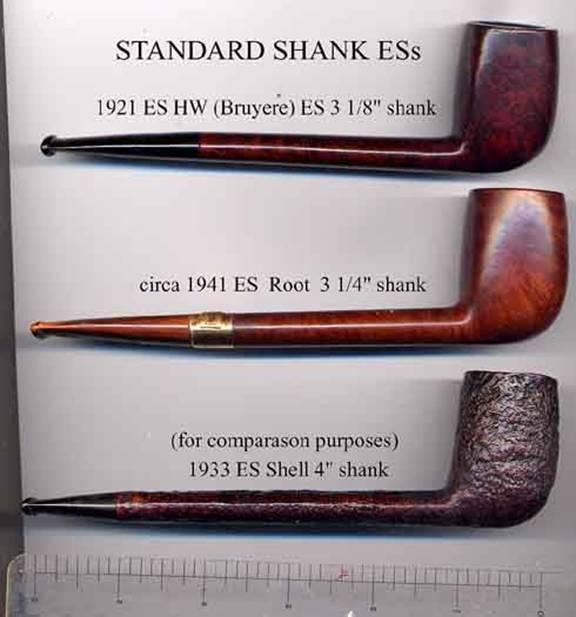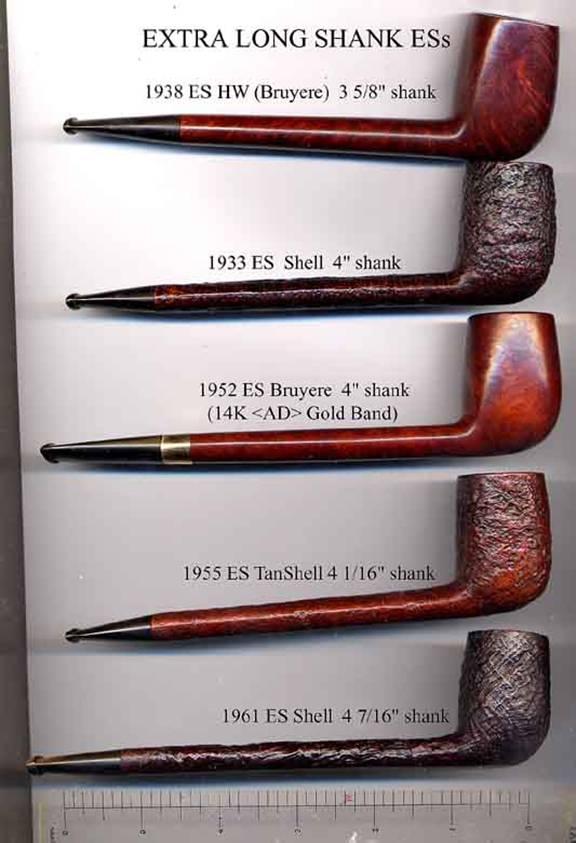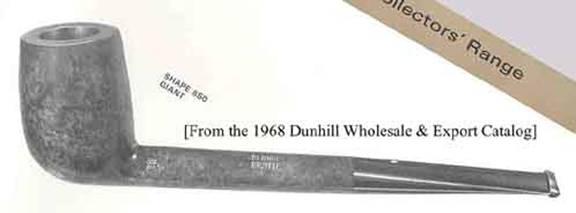LA CANADIENNE DUNHILL À TIGE EXTRA LONGUE
<language />
LA CANADIENNE DUNHILL À TIGE EXTRA LONGUE
© 2001 JOHN C LORING
Contributed and translate by Jean-Christophe Bienfait
Depuis le milieu des années 1970, Dunhill a marqué ses pipes d' un code numérique composé de chiffres qui classe les pipes par taille, type de tuyau et forme de tête ou en d'autres termes un système de codage numérique composite dans lequel un code donné englobe plusieurs types de pipes similaires mais distinctes.
Cependant, avant le milieu des années 70, les codes Dunhill classiques de l'époque n'étaient pas composites. Ou plutôt chacun de ces codes classiques désignait une forme distincte de pipe même si à quelques petites variations de forme (par ex. Un tuyau saddle plutôt que taper) correspondait un numéro de forme différent. Bien sûr il n'y a rien d'absolu, des formes portant le même codage classique ont évolué au cours des ans. Par exemple le tuyau des formes 120 et LC classique ¾ courbe des années 20 avait une courbure élégante qui s'est perdu dans les décennies suivantes et les 120 et les LC de la fin des années 20 sont parfois nettement plus grandes que leurs soeurs plus précoces ou plus tardives.
Mais les formes Dunhill designées dans la codification classique d'avant le milieu des années 70 étaient quasiment toujours cohérentes, entres elles pour une année donnée, et, d'année en année, à quelques minimes exceptions près. Il semblerait qu'il existe toutefois une exception, en ce qui concerne les formes des Dunhill canadiennes à longue tige, les ES, ODA 850 et ODA 851. Cet article a pour but l' examen approfondi de ces formes et l'exposé de mes hypothèses à ce sujet.
Dunhill a fabriqué des canadiennes depuis les années 1910 avec la "ES" ('extended shank' ? -c.a.d. tige allongée?-) qui était sa canadienne à longue tige. Durant plus d'un demi siècle, des années 10 au milieu des années 70, la pipe ES typique était cohérente, une tête de billiard classique de taille moyenne et une fine tige ovale, longue à peu près de trois pouces (7,7 cm) mesuré du pied du fourneau jusqu'à la jonction tige/tuyau. De temps en temps au cours des années 20 le foyer de la ES a gagné un peu de poids, elle a été un brin plus grand ou un brin plus épaisse mais pour ainsi dire au final la ES typique de 1975 ne différait pas de façon significative de ses débuts dans les années 1910.
Pourtant, à la différence des autres formes Dunhill standard que je connais, durant ce demi siècle de cohérence apparente on trouve en de rares occasion des versions de ES avec des tiges significativement plus longues, allant de 4 pouces jusqu'à 4 pouces ½ de long -10 à 11,5 cm-, (4 7/16 de pouces étant la plus longue que j'ai jamais vue ou dont j'ai entendu parler) , avec des têtes rappelant un peu celles légèrement plus petites du début des années 20.
This is not, as in the case of the 120 or LC a one or two year phenomena or a mid stream shape change implemented consistently thereafter, but rather it seems to be a significant variation that apparently might be found, albeit rarely, in any given year that the ES was produced (although most examples seem to come from the 1950's - 1960s era). It is as if two quite distinct shapes share the same shape number – the typical version with an approximately 3” shank and the rare version with an approximately 4” shank - notwithstanding that this was 'forbidden' under the individualized Dunhill shape identification system employed prior to the mid 1970s.
The question of course is why? Initially I suspected that the answer lay twixt the dreams of pipe smokers and the realities of pipe making. Many pipe smokers who like the Canadian shape want the longest possible shank but the reality of pipe making is that the Canadian is a costly shape to make. The longer the shank the more raw briar is required, additional briar that might otherwise produce a second pipe. And the longer the shank the greater the chance of briar flaws wasting the entire pipe. I believed that Dunhill didn't offer an extra long, 4" - 4 1/2", shank Canadian as a standard shape simply because after taking into account the wastage of time and material that would be involved it determined that it could not profitably make such a shape within its overall price structure. Indeed I came to conclude that even with the typical ES Dunhill knowingly stretched its then shape identification system by aiming for a 3 1/4" shank but settling for anything longer then 2 3/4", i.e. approximately 3" long, in a shape system that distained 'approximate'.
But if the foregoing might explain why Dunhill didn't offer an extra long shank Canadian as part of its standard line, that doesn't explain why in fact we do on rare occasion find ESs with extra long shanks of 4” – 4 ½”. That answer I not so long ago concluded lay in the adage of never looking a gift horse in the mouth. Pipe makers were probably instructed that when it looked like the briar would allow for an extended shank they should take advantage of it. If a 4" shank ES might not be a 'proper' ES it would none the less certainly be welcomed by discerning Dunhill customers.
More recently I have brought the ODA Canadians into my considerations. In 1949 Dunhill began to develop a new line of oversized standard shapes. They were termed 'Giants,' given three digit shape numbers beginning with an "8" and price stamped "ODA". Three of those new shapes were Canadians, the 845, 850 & 851.
The 845, the most commonly found ODA Canadian, is in fact a fairly typical post WWII 'ODA' pipe. It has a significantly larger bowl then the ES and is usually found with a 2 ¾" – 3 ¼” oval shank. Reportedly one or two 845s were produced with shanks as long as 3 ¾” but none in the 4” or 4” + category addressed in this paper.
On the other hand both the 850 and 851 while atypical post war ODAs as both have small, group 4 size, bowls, are quite pertinent for the purposes herein for like the ES they may be found on rare occasion with 4" and longer shanks.
The 851 is a very rare pipe in any form, I have heard of only a handful and am familiar with only the one I own. Interestingly, my 851 is in most all respects an extra long shank long ES although on close examination one finds that the bowl is slightly larger and the 4 1/8" shank is decidedly thicker at the bowl with a taper that thins to the bit. As the bit on my 851 is significantly longer then a normal ES bit the pipe as a whole is longer then an ES. It has a 'heftier' feel as compared to a long shank ES, but ignoring the greater overall length of the 851 due to its longer bit, one would be hard pressed at first glance or from a distance to distinguish between the two. One might assume that it was given Giant/ODA status because of the extra long shank but in fact I have been advised that most of the other known 851s have shorter shanks then mine.
More commonly found, the 850 is one of the few Giant/ODAs to be actually pictured in a Dunhill catalog (the 1968 Wholesale/Export). As pictured in that catalog one finds that its bowl and shank are slightly smaller and shorter the those of a typical ES and that the pipe is about the same overall length of the typical ES only because of a rather long, ‘851ish’, bit. However, as actually found outside the catalog, in collections, at pipe shows and on eBay, the 850 is almost indistinguishable from the typical ES with a, longer then shown in the catalog, 3 1/4" shank and a shorter, then shown in the catalog, bit. Looked at closely though the 850 shank, like that of the 851, is a thicker at the bowl with a slight taper to the bit. That is, while the 850, 851 and ES are all quite similar, the 850 and 851 seem to differ from the ES principally in that the latter has a flat oval bit while the former two have tapered oval bits, and continuing, the 851 differs from the 850 in that the former has a longer bit and is overall a longer pipe. And returning to the principal emphasis of this paper, like the ES and 851, on rare occasion the 850 too is found with a 4” or longer shank.
Thus like the ES both the 850 and 851 appear to have two variants, the commonly found 3” (or so) shank and the rarely found 4” (or so) shank. Initially it appeared to me that while I had turned to the Canadian ODA shapes to shed some light on the ES extra long shank variation, I had instead found the same variation without an answer. But perhaps not, for then I realized that while I had been concentrating on shank length my review of ODA Canadian shapes had forced me to look at the overall pipe length. Putting aside my new questions over why Dunhill had three virtually identical pipe shapes, it occurred to me that the answer to my initial ‘variant’ question lay in the overall pipe length of each shape. And looking at both the 850 and ES I found that indeed while shank lengths may differ, within each shape the overall length of the pipe was essentially the same, the length of the bit varying depending upon the length of the shank. The rare 4”+ shank length variation remains but its continued intermittent existence without unique shape numbers for over a half century within Dunhill’s classic shape number system is explained. Dunhill simply allowed for the occasional rare extra long shank by focusing the ES and 850 shape specifications on the overall length of the pipe with a minimum shank length requirement. (Of course this does not explain my pictured 1961 ES which is a ½” longer in overall pipe length then customary, but what pipe maker could ever contemplate cutting down its 4 7/16” shank.)
But initial question resolved, a new question remained. Why in the 1950s did Dunhill introduce ODAs that were for all intents and purposes an ES? In answer I return to the 1968 wholesale / export catalog. That catalog is fairly extensive and covers a full range of Dunhill pipes, including the Giant/ODA 850 and the EC, a distinctly smaller version of the ES, but surprisingly, not the more popular ES. More popular but also, even at its typical 3" shank length, a decidedly more expensive standard shape to produce. I can not claim certainty but it seems to me that perhaps Dunhill hoped that in time it would be able to quietly drop the ES from its standard shape line in favor of the higher priced ODAs. Of course in the upshot Dunhill dropped the “ES” in the course of dropping the entire shape number system in the mid 1970s and effectively the ODA 850 and 851 shapes similarly disappeared.
Typically one can deal with older Dunhill pipes simply on the basis of shape number, date code and a question or two on condition, but the ES and 850 are the exception for rare examples of pipes deceptively bearing those shape numbers but with extra long shanks of 4” or more remain to be found. Good hunting.


